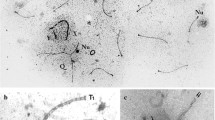Abstract
Aedes aegypti spermatocytes were reconstructed from electron micrographs. The species has tight somatic pairing of the chromosomes, and there are therefore no classical leptotene and zygotene stages, but rather a gradual transition from somatic pairing to meiotic pairing (= pachytene). The term “prepachytene” has been used for the transitory stage. The first visible sign of impending meiosis was a reorganization of the chromatin, which resulted in the formation of spaces (synaptic spaces) in the chromatin, about the width of the synaptonemal complexes (SCs). Diffuse material, possibly precursor material for the SC, was present in the spaces. Later short pieces of complex were formed throughout the nucleus. Late prepachytene, pachytene, and diplotene complexes were reconstructed. Each chromosome occupied a separate region of the nucleus. The complexes became progressively shorter from prepachytene (maximum complement length 289 μm) to diplotene (175 μm). The thickness of the SCs increased from prepachytene to pachytene and probably decreased again during diplotene. At the beginning of diplotene the lateral elements (LEs) separated, and the single LEs became two to three times thicker than the LEs of the SC. The centromeres were at all stages attached to the nuclear membrane, whereas the telomeres were free in the nucleoplasm during pachytene and diplotene. A heterochromatic marker was present on chromosome 1 near the sex determining locus, and a diffuse marker on chromosome 3 near the nucleolus organizer region. After breakdown of the complexes, polycomplexes were present in the nucleus.
Similar content being viewed by others
References
Abirached-Darmency M, Zickler D, Cauderon Y (1983) Synaptonemal complex and recombination nodules in rye (Secale cereale). Chromosoma 88:299–306
Akstein E (1962) The chromosomes of Aedes aegypti, and of some other species of mosquitoes. Bull Res Counc Isr B 11:146–155
Carpenter ATC (1975) Electron microscopy of meiosis in Drosophila melanogaster females. I. Structure, arrangement, and temporal change of the synaptonemal complex in wild type. Chromosoma 51:157–182
Carpenter ATC (1979) Synaptonemal complex and recombination nodules in wild-type Drosophila melanogaster females. Genetics 92:511–541
Craig-Cameron TA, Southern DJ, Pell PE (1973) Chiasmata and the synaptinemal complex in male meiosis of Glossina. Cytobios 8:199–207
Fiil A, Moens PB (1973) The development, structure and function of modified synaptonemal complexes in mosquito oocytes. Chromosoma 41:37–62
Fiil A (1978) Meiotic chromosome pairing and synaptonemal complex transformation in Culex pipiens oocytes. Chromosoma 69:381–395
Fuge H (1979) Synapsis, desynapsis, and formation of polycomplex-like aggregates in male meiois of Pales ferruginea (Diptera, Tipulidae). Chromosoma 70:353–373
Gillies CB (1972) Reconstruction of the Neurospora crassa pachytene karyotype from serial sections of synaptinemal complexes. Chromosoma 36:119–130
Gillies CB (1975) Synaptonemal complex and chromosome structure. Ann Rev Genet 9:91–109
Grell SM (1946) Cytological studies in Culex. II. Diploid and meiotic divisions. Genetics 31:77–94
Holm PB (1977) Three-dimensional reconstruction of chromosome pairing during the zygotene stage of meiosis in Lilium longi-florum (Thunb.) Carlsberg Res Commun 42:103–151
Jordan EG, Luck BT (1976) The nucleolus organizer and the synaptonemal complex in Endymion non-scriptus (L.). J Cell Sci 22:75–86
Joseph AM, Chandley AC (1984) The morphological sequence of XY pairing in the Norway rat Rattus norvegicus. Chromosoma 89:381–386
McDonald PT, Rai KS (1970) Correlation of linkage groups with chromosomes in the mosquito, Aedes aegypti. Genetics 66:475–485
Mescher SRAL, Rai KS (1966) Spermatogenesis in Aedes aegypti. Mosquito News 26:45–51
Mirre C, Hartung M, Stahl A (1980) Association of ribosomal genes in the fibrillar center of the nucleolus: A factor influencing translocation and nondisjunction in the human meiotic oocyte. Proc Natl Acad Sci USA 77:6017–6021
Moens PB (1973) Quantitative electron microscopy of chromosome organization at meiotic prophase. Cold Spring Harbor Symp Quant Biol 38:99–107
Moses MJ (1968) Synaptinemal complex. Ann Rev Genet 2:363–412
Moses MJ, Poorman PA, Roderick TH, Davisson MT (1982) Synaptonemal complex analysis of mouse chromosomal rearrangements. IV. Synapsis and synaptic adjustment in two paracentric inversions. Chromosoma 84:457–474
Motara MA, Rai KS (1977) Chromosomal differentiation in two species of Aedes and their hybrids revealed by Giemsa C-banding. Chromosoma 64:125–132
Munstermann LE, Craig GB (1979) Genetics of Aedes aegypti. J Hered 70:291–206
Newton ME, Southern DJ, Wood RJ (1974) X and Y chromosomes of Aedes aegypti (L.) distinguished by Giemsa C-banding. Chromosoma 49:41–49
Newton ME, Wood RJ, Southern DJ (1978) Cytological mapping of the M and D loci in the mosquito, Aedes aegypti (L.), Genetica 48:137–143
Rai KS (1963) A comparative study of mosquito karyotypes. Ann Entomol Soc Am 56:160–170
Rasmussen SW (1974) Studies on the development of the synaptinemal complex in Drosophila melanogaster. Compt Rend Trav Lab Carlsberg 39:443–468
Rasmussen SW, Holm PB (1978) Human meiosis. II. Chromosome pairing and recombination nodules in human spermatocytes. Carlsberg Res Commun 43:275–327
Roth TF (1966) Changes in the synaptinemal complex during meiotic prophase in mosquito oocytes. Protoplasma 61:346–386
Searle AG, Beechey CV, Boer P de, Rooij DG de, Evans EP, Kirk M (1983) A male-sterile insertion in the mouse. Cytogenet Cell Genet 36:617–626
von Wettstein D (1977) The assembly of the synaptinemal complex. Phil Trans R Soc Lond B 277:235–243
von Wettstein D, Rasmussen SW, Holm PB (1984) The synaptonemal complex in genetic segregation. Ann Rev Genet 18:331–413
Wandall A, Svendsen A (1983) The synaptonemal complex karyotype from spread spermatocytes of a dipteran (Aedes aegypti). Can J Genet Cytol 25:361–369
Westergaard M, von Wettstein D (1972) The synaptinemal complex. Ann Rev Genet 6:71–110
Author information
Authors and Affiliations
Rights and permissions
About this article
Cite this article
Wandall, A., Svendsen, A. Transition from somatic to meiotic pairing and progressional changes of the synaptonemal complex in spermatocytes of Aedes aegypti . Chromosoma 92, 254–264 (1985). https://doi.org/10.1007/BF00329808
Received:
Revised:
Issue Date:
DOI: https://doi.org/10.1007/BF00329808




